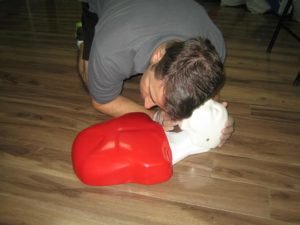It is a known fact that certain events can cause an individual to stop breathing, including an allergic reaction, accident or abrupt medical illness. Once this occurs, it is essential to provide rescue breathing to an unconscious individual as soon as possible. If you will enroll in a first aid course, you will learn the correct steps and the technique in order to help save a life in any emergency scenario.
Step on rescue breathing

- You have to shout for help and ask anyone that can hear you to call for emergency assistance.
- Lay the individual on his/her back gently. Position the palm of your hand on the forehead of the individual and press gently back while cupping the fingers beneath the chin to lift it. Take note that this will cause the head to tilt back, opening up the airway.
- Check if the chest of the individual is rising. Position your ear close to the mouth of the individual and listen for breathing while at the same time feeling for breath on your cheek. If you are certain that the individual is not breathing, use two fingers in a sweeping manner to feel if there are any objects present in the mouth that might obstruct the airway.
- In case the mouth is free from any objects, maintain the head tilted with the chin raised. With your thumb and first finger, pinch the nose of the individual and then place your lips over the open mouth of the individual.
- Deliver a blow in a slow and deep manner while watching for the rise of the chest. Remove your mouth and allow the air to expel and then repeat. If the chest does not rise, you have to reposition the head of the individual and make sure that the nostrils are pinched securely or closed between your fingers.
- Once two breaths are delivered, you have to check for a pulse by positioning two fingers on the pulse point in the neck. You have to lean toward the mouth and check for breathing. In case the individual is still not breathing but has a pulse, continue the process. If the pulse is absent, you have to perform CPR.
- You have to continue to deliver one breathe for every five seconds between breaths until the medical team arrives on the scene if it is an adult with a pulse but the breathing is absent. As for children between 1-8 years old that has a heartbeat but not breathing, you have to deliver one slow breath every three seconds. You have to continuously monitor for a pulse and breathing every 10 seconds.
It is important that you are familiar on how to perform rescue breathing so that you can help save a life during emergency scenarios.
